Arts Miami
Tony Japour Visits CVC in Wynwood
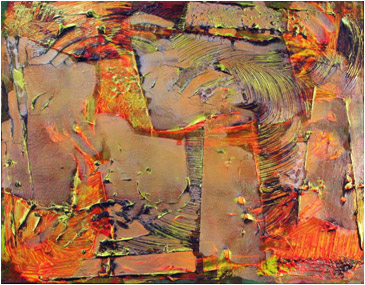

Anthony Japour (AJ) is an independent curator, private art dealer and owner of AJ Japour Gallery. The gallery deals in contemporary art with a focus on the Chinese Contemporary Art Movement and its relationship to the pillars of Western Contemporary Art. Since 2003, AJ has produced numerous art exhibitions and installations in Miami and South Florida. In addition, the Gallery’s secondary mission is to support organizations dedicated to the health, education, and welfare of children. AJ has served on the Fine Arts Board and the Cultural Arts Council of the City of Miami Beach.
The Center for Visual Communication (CVC) in the Wynwood Arts District is one of Miami’s hidden gems. While the not-for-profit organization has been around for more than 20 years, its move to its current location at 541 NW 27th St, adjacent to the Margulies Collection at the Warehouse heralded a major leap in ambition and scale.
I first came to know about the CVC in 2008 during the Art Basel Miami Beach when I hosted a series of panel discussions at the CVC sponsored by Art & Antiques magazine on the Chinese Contemporary Art Movement. That year, the CVC mounted one of its most important exhibitions to date, a major Robert Rauschenberg Printmaking Retrospective, now a traveling exhibition. Barry Fellman who has been the director of the CVC for the last 10 years is committed to bringing high quality programming to the organization that states its mission: to present in depth exhibitions of work by nationally recognized artists and accomplished local and regional artists.
Fellman has organized numerous exhibitions of contemporary art in New York and Miami and has spearheaded the CVC’s joint projects with local and US government agencies including Biscayne National Park, Art in Public Places, DERM, Miami-Dade Transit Authority and the Performing Arts Center bringing visual art to public venues. Currently the CVC is exhibiting a 20 year retrospective of Darby Bannard, co-founder with Frank Stella of the Minimalist movement and Head of Painting of the Department of Art & Art History at the University of Miami, and an installation of works by the artist duo known as Guerra de la Paz.
Darby Bannard
The Miami Years- Celebrating 20 years of Abstract Painting
Guerra de la Paz
Beyond the Daily Life
Center for Visual Communication
541 NW 27th St.
Miami, FL 33127
www.visual.org
What unites these two exhibitions is one thing – an explosion of color!
Bannard, who was awarded a Guggenheim Fellowship in the 1960’s, has been painting in abstraction for a half-century. The appropriate subtext for the current exhibition “Then & Now” contrasts Bannard’s rather dark, imposing and academic paintings he executed while living in the northeast with a transition to brightly colored canvases such as Hardaway, 1992 that he created after moving to the Sunshine State. Using semi-transparent acrylic gel, street brooms and floor squeegees, he invented a technique he calls “brush & cut.” One sees his iterative processing and re-processing theory changing one aspect at a time and keeping all others constant – much like a scientist would test different theories in a laboratory setting.
My favorite ones were those in which he added iridescent and interference pigments bringing to mind iridescent tropical marine fish swimming in the Atlantic Ocean. As a strict abstractionist, however, Bannard avoided any figuration until the beginning of the twenty-first century when one begins to see figures emanating out of the pools of paint. Bannard’s works are held in many of the major museums in the United States.
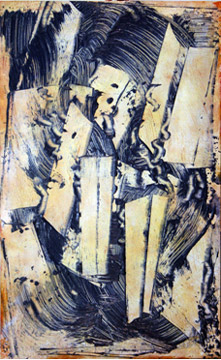

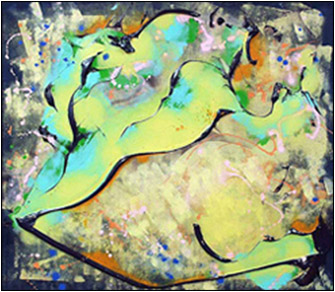
“WOW!” was the first reaction I had when the lights went on the work of Guerra de la Paz, the two-artist team of Alain Guerra and Neraldo de la Paz. Having had a vague recollection of seeing these artists’ works somewhere before but not being able to place where, I was immediately taken by the scale and the beauty of these textile sculptures. The artists are commenting on mass-produced refuse on our consumer (and consumptive) society by using layer upon layer of bright-colored garments that are used like pigments of paint. Ironically, the exhibition is housed in the heart of the “garment district” in Wynwood where I was just walking by wondering where in the world the aisles and aisles of garments go. Viewing the works brought to mind Yin Xiuzhen, an emerging Chinese contemporary artist with a recent installation at the Museum of Modern Art. She uses recycled garments and suitcases to create her “Portable Cities” series in which she comments on the transient nature of our global society whereby we are always packing and re-packing our suitcases, constantly on the move.
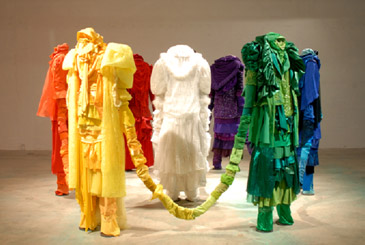
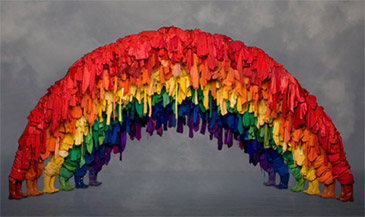
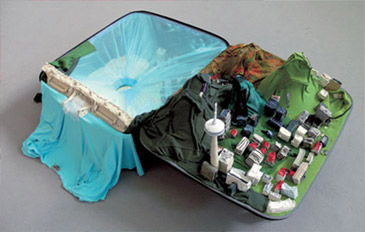
Similar lines of thinking occur often among artists, and one work by Guerra de la Paz entitled Ascension 2009 reminded me strikingly of a work I saw last fall by artist Anish Kapoor, Spire, 2009 in Oudenberg, Belgium. When I saw the Kapoor’s Spire out in the farm fields, I couldn’t help but think of Monet’s Haystacks at Giverny. Monet painted the Haystack series to show the differences in the perception of light across the time of day. Interestingly, Kapoor in Spire, 2009 uses a reflective material, namely stainless steel, that when outdoors interacts with the natural light throughout the day creating a constantly changing effect across the sculpture.
Having had this previous experience with Monet and Kapoor, I viewed the Guerra de la Paz’s, Ascension, 2009, as a further extension of this concept where now one views the use of reflective fabrics and artificial light in an indoor setting to stimulate and challenge the eye. In yet another art viewing twist, a few years ago, Anish Kapoor installed his version of Ascension at the Galleria Continua- Beijing consisting of smoke, air and space in one of the more truly startling art viewing experiences in my life.
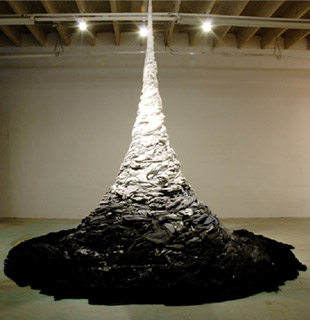
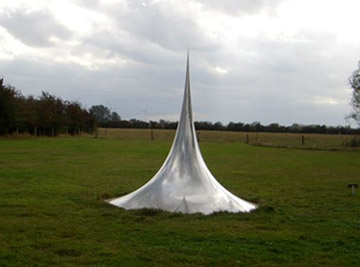
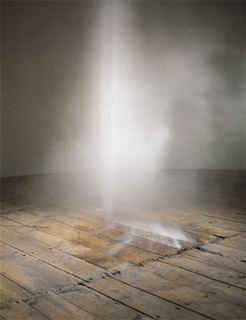
Ask AJ
Dear AJ: How can an Anish Kapoor sculpture be worth $1.5 million dollars? Rita Rose
Dear Rita Rose: The “art transaction” is among the purest forms of capitalism that exists in the world today. That is, the value of work is whatever someone else is willing to pay for it. In an auction setting for a specific work of art, the value is usually set when at least two people are bidding for the same work. Sometimes a collector just has to have one particular work to complete his/her art collection and is willing to pay top dollar. Within an artist’s oeuvre, provenance, exhibition history, year of output, intrinsic qualities as well as a kind of je ne sais quoi all contribute to the true value of the work.
In the case of Anish Kapoor, he is an internationally recognized sculptor with numerous museum exhibitions to his name. Kapoor often works in expensive materials, including highly polished stainless steel; the fabrication costs alone are very expensive. To me, he and Richard Serra are without question the most important sculptors of our time. He is constantly pushing the limits and truly resides on the cutting edge of the contemporary art of our time.
Please email questions you’ve always wanted to ask, comments, or suggestions for future columns to Anthony Japour at info@ajjapourgallery.com
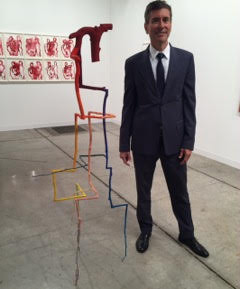
Anthony Japour is an art collector and art advisor. Japour lectures on the Chinese Contemporary Art Movement and its relationship to the pillars of Western Contemporary Art. For over a decade [2002-2012], Japour mounted numerous art exhibitions and installations in Miami Beach and South Florida through AJ Japour Gallery and linked these exhibitions to charity events at his home in South Beach devoted to the health, education and welfare of children. Japour has served on the Fine Arts Board and the Cultural Arts Council of the City of Miami Beach. Japour has been a contributor writing on contemporary art for SocialMiami.com since 2010.


